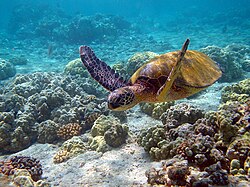Raine Island
It has been suggested that this article be merged into Raine Island (Queensland). (Discuss) Proposed since July 2007. |
11°35′S 114°02′E / 11.583°S 114.033°E

Raine Island is a vegetated coral cay that is 32 hectares in total area and is situated on the outer edges of the Great Barrier Reef, approximately 620 kilometres North north west of Cairns, Queensland, Australia.[1] Raine Island is the site of the oldest European structure in all of tropical Australia, a stone beacon built in 1844, and harbours the world's largest remaining population of Green Turtles (Chelonia mydas).[2]
More than thirty shipwrecks can be found off the coasts and beaches of Raine Island. Such ships include the HMS Pandora, a vessel that was involved in the capture of a group of mutineers off the HMS Bounty.[2][3] In addition to being a populous Green Turtle sanctuary, Raine Island is a rookery to a vast amount of seabirds, amounting to perhaps the most significant seabird rookery in the whole of the Great Barrier Reef.[2]
The stone beacon that resides on Raine Island was built (in 1844) through convict labour, on orders of the British Admiralty. The stone used in the construction of the beacon was quarried from phosphorus stores found on the island itself, the timber and wood salvaged from broken shipwrecks, and shells burnt to make lime for mortar. The structure took a period of four months to complete.
While the beacon was never actually lit, it is visible over 13 nautical miles from the island. Many years have seen the structure grow heavily damaged; undermining, stone bedding loss, natural damaging, harsh weather and lightning strikes have all contributed to the erosion of the beacon. In 1994, to, at least in part, restore the beacon, the Raine island Corporation underwent an effort to repair and shield the beacon from lightning strikes. The raine Island Corporation was subsequently awarded a John Herbert Award for Excellence in Heritage Conservation Works or Action for their work on maintaining the monument.[4]
Geographically, Raine Island is located close to other notable cays, such as Moulter and Maclennan Cays. To preserve the wildlife and natural splendour of Raine Island, access to the general public is generally prohibited, and is mostly limited to those involved in specific conservation and management research.[2]
Notes
- ^ "Raine Island".
{{cite web}}: Unknown parameter|accessmonthday=ignored (help); Unknown parameter|accessyear=ignored (|access-date=suggested) (help) - ^ a b c d "Raine Island Corporation".
{{cite web}}: Unknown parameter|accessmonthday=ignored (help); Unknown parameter|accessyear=ignored (|access-date=suggested) (help) - ^ Alexander, Caroline. The Bounty: The True Story of the Mutiny on the Bounty (2003)
- ^ "History of the raine Island Beacon".
